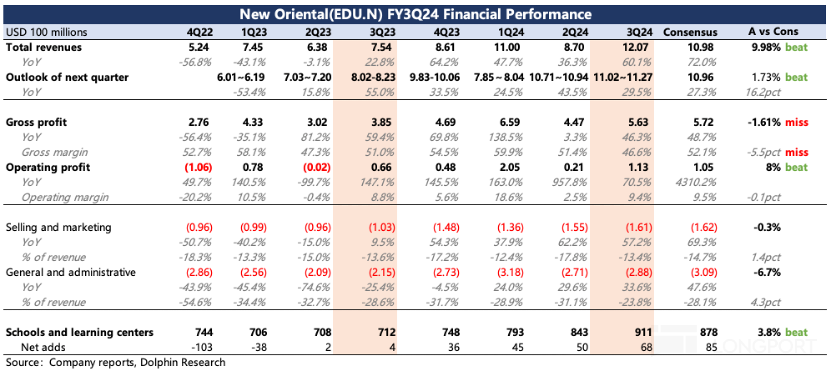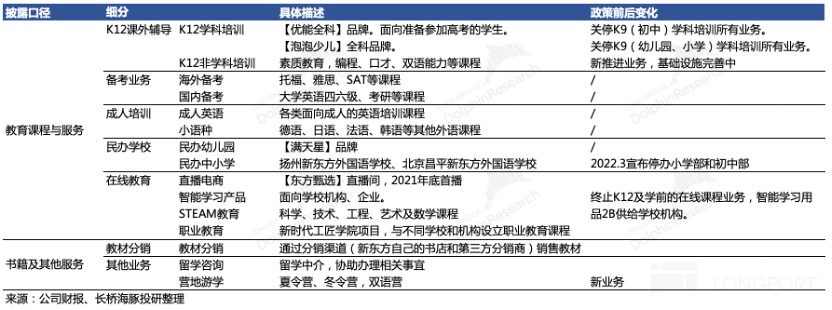
 Likes Received
Likes Received Posts
PostsNew Oriental: Improved Resource Utilization, Increased Capacity Expansion Targets (Fiscal Q3 Earnings Call)
FY24Q3 Interpretation Meeting Summary for New Oriental Education & Technology Group Inc.:
Below is the summary of the third quarter financial report conference call for New Oriental Education & Technology Group Inc. For a detailed interpretation of the financial report, please refer to " New Oriental: Live Broadcasting Drags Down Profits, Education Supports the Family Again 》
1. Review of Core Financial Information:


2. Detailed Content of the Financial Report Conference Call:
2.1. Key Points from Management Statements:
- Business Highlights:
① Significant revenue growth was achieved in overseas test preparation business, study abroad consulting business, as well as adult and college student business, with growth rates (in USD) of 53%, 26%, and 53% respectively.
② New Oriental launched non-academic courses for children, available in approximately 60 cities, focusing on cultivating innovation and comprehensive qualities. Approximately 355,000 students were registered this quarter.
③ Introduction of intelligent learning systems and devices to provide students with customized digital learning experiences. Approximately 188,000 active paying users this quarter.
④ New Business Line: New Oriental has initiated a cultural tourism business line, offering services such as study tours and research camps in over 50 cities nationwide. The revenue from the top ten cities accounts for over 55%.
2) Financial Highlights:
① Operating costs and expenses: Operating costs and expenses for this quarter amounted to USD 1.0939 billion, a year-on-year increase of 59.1%, mainly due to significant growth in self-branded products and live e-commerce business.
② Share Repurchase Program: The board of directors has authorized the repurchase of up to USD 500 million of the company's ADS or common stock from July 2022 to May 2024. As of April 23, 2024, the company has repurchased approximately 6 million ADS, totaling around USD 195.3 million.
3) Guidance and Outlook:
① Fourth Quarter Revenue Expectation: The total net revenue for the fourth quarter of 2024 is expected to be between USD 1.1015 billion and USD 1.1273 billion, with a year-on-year growth rate of 28% to 31% (in USD)② Expansion: The plan for this fiscal year is to increase the capacity of learning centers and classroom spaces by about 30%, open new learning centers in cities with good performance, expand the classroom areas of existing learning centers in some major cities, continue to recruit new teachers and staff to support capacity expansion and revenue growth, especially in new educational initiatives and newly integrated tourism-related businesses.
③ Investment Direction: Will continue to invest in researching and applying new technologies, such as artificial intelligence and ChatGPT, to improve service quality and operational efficiency. At the same time, will cooperate with various provincial and municipal government departments in China to ensure that business operations comply with relevant policies and regulations.
2.2 Q&A Analyst Q&A
Q: Regarding growth, there may be some seasonal impact on the education business in the fourth quarter, can you share the growth situation in different business areas? Also, the expansion guidance for this year has been raised to 30%, what is your view on the future expansion speed? Is this 30% expansion rate sustainable for two to three years?
A: The revenue guidance for this quarter is slightly lower compared to the past few quarters. First, we have been slightly conservative in our revenue guidance for this quarter. Second, because the fourth quarter is usually a slow season, especially for K-12 and overseas businesses. Third, last year's same period was not affected by the epidemic, so compared to last year, we expect revenue to decrease slightly.
However, we remain optimistic about revenue growth in the fourth quarter, expecting a growth rate in USD between 28% to 31%, and in RMB between 34% to 37%. As for the expansion plan, we plan to increase the annual expansion rate by 30% as we are capturing more market share.
Looking ahead to Q4, we plan to maintain a similar pace of expansion and expect revenue growth rates in various business areas to be 15% to 20% (overseas business), 20% to 25% (domestic exam tutoring), moderate growth (high school tutoring), and over 60% (new business). These forecasts are based on our exchange rate estimates.
Q: If we only consider the education business, how is it expanding on an annual basis? What are your expectations for the trends in the coming quarters?
A: Yes, the overall non-GAAP operating profit margin of the group remained stable in this quarter. However, in terms of the education business, we have seen significant expansion in gross profit margin and non-GAAP operating profit margin. This is attributed to the new business structure model, improved resource utilization, and optimized cost structure, factors that have once again expanded the profit margin of the education business this quarter.
In the future, we expect operational leverage for 24 Q4 and the entire FY25. We have raised the guidance for learning center expansion, hired more employees to match the new expansion. In FY25, we expect revenue growth to remain strong, and the profit margin of the education business will also expand. As for Eastern Selection, the increase in sales and marketing expenses is mainly due to some investments made in it, and we have seen positive effects on its revenue growth, especially in 1P brand products and e-commerce business. We are confident in the growth of Eastern Selection and look forward to fully leveraging these investments in the futureOverall, we are optimistic about the profit margin expansion of the education business and the entire group for FY25. At the same time, we believe that Eastern Selection will bring more revenue growth and profit to the company in the future.
Q: From the perspective of minority equity interests, Eastern Selection may be in a loss position this quarter. How should we view the impact of the profit margin fluctuations of Eastern Selection on our overall group in future quarters and fiscal years? What are the profit margin plans for the next fiscal year?
A: I'm afraid I cannot share the latest financial results and guidance on Eastern Selection at this time. I suggest that in the next quarter, in July, Eastern Selection will release their annual and semi-annual reports, and management will provide more information. We are optimistic about our investment in Eastern Selection this quarter. In the long run, we believe this investment will bring more revenue and profit, with a promising future.
Q: What are the retention rates and utilization rates for the expansion of the high school learning centers and non-academic course learning centers?
A: For the high school business and K-9 non-academic courses, both the utilization rate and student retention rate have been increasing year by year and quarter by quarter. This trend is good news for us, and we expect the utilization rate and student retention rate of existing learning centers to further increase in the future. Previously, it usually took us 12 months to achieve a break-even point for new learning centers, but now this time has been shortened to about half a year. Therefore, looking ahead, we anticipate an increase in the utilization rate of learning centers and an improvement in student retention rates across all business lines.
Q: The gross profit margin for this quarter has decreased by about 5 percentage points compared to the same period last year. Is this due to the expansion of learning centers or other factors?
A: The expansion of learning centers is a significant factor. We have once again raised the guidance for learning center expansion to 30%, which is a comprehensive analysis of the overall business situation over the past two to three quarters. The demand is very strong, especially for cash courses in non-dynamic courses.
In terms of competition, the current competitive environment is different from a few years ago. We have only selected cities that perform the best, both economically and in terms of performance, to allow them to expand the course area of existing learning centers. This will not have a negative impact on overall profit margins; on the contrary, it will help expand profit margins in the future.
Q: I noticed a slight decrease in operating cash flow for this quarter compared to the same period last year. Could you share some reasons or underlying reasons for this? Secondly, there is a question about financing cash flow. I noticed that the existing stock repurchase plan is about to expire. Regarding your capital allocation and shareholder returns, have you considered possible dividend or stock repurchase plans for future shareholder policies?
A: For operating cash flow, I suggest investors conduct an annual comparison analysis rather than a quarterly comparison, as there may be changes in the business's seasonality or student enrollment windows. So I recommend an annual analysis. If you notice that the deferred revenue balance is still growing strongly annually. This is also why we have provided strong revenue guidance for Q4, even though Q4 is a soft quarterRegarding the stock buyback plan, we will continue to create value for shareholders and repurchase stocks. We have completed about half of it, approximately $194 million. We will continue to repurchase in this quarter and discuss with the board of directors at the end of this fiscal year whether to extend the stock buyback plan. Our goal is to create more value for investors through stock buybacks or dividend distributions.
Q: We noticed a larger investment loss under the equity method this quarter, as well as less investment interest compared to the same period last year. What factors led to these changes?
A: In this quarter, we incurred substantial impairment losses on investment companies, which had a one-time impact on this quarter's net profit. I believe both companies were negatively affected by the dual reduction policy 2.5 years ago, but this impact is only one-time, not long-term.
Q: We saw a decrease in other income this quarter, is this mainly due to the decrease in investment interest?
A: Interest rates in China have decreased, affecting some interest income this quarter. In fact, the absolute amount of interest income is similar to the previous one to two quarters, very stable.
Q: I would like to know about the situation regarding the opening of new centers. Previously, it generally took about a year to break even for K-12 AST learning centers, and then several more quarters to fully reach profitability. Now, considering that the courses are mainly non-academic, has this situation changed?
A: Nowadays, new learning centers reach break-even in an average of six months, faster than before, and in the second year, the profit margin of new learning centers is usually between 15% and 20%, much better than before. This is one of the reasons why we decided to increase the guidance for expanding learning centers by 30%. In the upcoming quarters, we will open more than 30% new learning centers, which will drive performance growth for FY25. I believe that due to better utilization and a higher student ratio, the profit margin of the entire education business in FY24 will improve.
Q: Do you think that faster break-even is just a matter of bringing forward the time for utilization growth? Do you think that even after break-even, the profit level of non-academic centers may be higher than that of past academic centers? Five years later, do you think the profit margin of some non-academic centers may exceed 20%, or even surpass the past K-9 academic centers?
A: I think it's both. First, as I mentioned, the time required to break even will be shorter, that's the first point. The second point is, overall, I believe the final profit margin of new learning centers will be slightly higher than a few years ago. So for us, opening more learning centers for non-academic courses or even overseas-related businesses is a good compromise.
Risk Disclosure and Statement of this article: Dolphin Investment Research Disclaimer and General Disclosure



